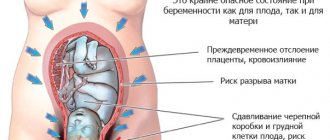Where does the fluid in the amniotic sac come from?
In the first trimester of pregnancy, it is produced by the cells of the amnion itself. In the last trimester, the baby's kidneys take an active part in the formation of fluid. The fetus swallows amniotic fluid, it is absorbed in its gastrointestinal tract and, together with urine, is excreted from the child's body back into the amnion. The water cycle in the amnion promotes the renewal of amniotic fluid every few hours throughout the entire 40 weeks.
The volume of fluid increases, increasing by 40-50 milliliters with each subsequent week of pregnancy. By about 38 weeks, its volume reaches a maximum of 1 to 1.5 liters. The amount of water in each specific case is determined by specialists, guided by the amniotic fluid index during an ultrasound examination.
Causes and consequences of green waters during childbirth
Ultrasound during pregnancy is one of the most exciting procedures. You always look forward to this correspondence with the baby. And it makes me very happy when they say that everything is fine. This happened to me at the first and second ultrasound. But on the third, the doctor added to my worries when he said - water with impurities. It’s difficult to immediately understand what this means. What is it with impurities, where do they come from and what does it mean? Then, during the birth, the midwife reported that the waters were green. She said this not to me, but to the nurse, and I again asked myself the question - what does this mean? Green water is not such a rare occurrence, let's figure out what it is and how dangerous it is for a newborn.
In my case, the doctors attributed the impurities in the amniotic fluid and its greenish tint to the pyelonephritis I suffered. My kidneys began to hurt sharply and severely; I needed IVs and antibiotic treatment. In this case, the presence of green waters did not surprise the doctors.
It happens that the water acquires this color when the mother walks with the baby, at 42-43 weeks.
Green waters can also be considered meconium - i.e. This is a situation in which original feces have passed from the fetal intestines into the amniotic fluid. Since meconium is green, the water also takes on a greenish color. Doctors believe that increased secretion of meconium can be triggered by fetal hypoxia, but this cannot always be confirmed. It happens that the waters are completely clean, but the signs of hypoxia are obvious. But sometimes it’s the other way around – “dirty” waters, but the baby is absolutely healthy.
The main trouble with the presence of foreign impurities in the amniotic fluid is that the fetus in the womb can swallow it. And also during the birth process, this fluid can get into the baby’s lungs. To prevent this from happening, the medical staff, when the head appears from the birth canal, checks the mouth and uses an aspirator to suck out the meconium fluid, if there was any there.
And although the presence of water with impurities is an indicator for a more thorough examination of the newborn, in fact, with the correct actions during childbirth, green amniotic fluid does not harm the baby.
What does amniotic fluid consist of?
Normally, amniotic fluid is clear and odorless. At the end of pregnancy, it may become slightly cloudy due to the entry of epidermal cells and waste from the sebaceous glands. The green tint of the water should alert specialists; this is one of the signs of intrauterine fetal hypoxia.
The amniotic fluid includes the baby's secretions (urine, discharge from the lungs), and the presence of oxygen, carbon dioxide, salts, fats, glucose, hormones and antigens that correspond to the baby's blood type.
What does it mean
Amniotic fluid is normally light-colored. When original stool (meconium) gets into them, they change color. If, when the water passes, it turns green, dark or light, this means that the child is suffering. He doesn't have enough oxygen. The most unfavorable thing for a newborn is thick, dark green amniotic fluid that looks like pea soup.
The main significance of this staining is the possibility of developing a complication - meconium aspiration syndrome. Practice shows that the presence of green waters increases the incidence of morbidity in newborns.
What are the functions of amniotic fluid during fetal development?
Throughout pregnancy, amniotic fluid provides reliable protection for the fetus from injury, bruises, blows and other mechanical damage. Besides
- this is a source of comfortable habitat for the embryo
- amniotic fluid is intensively involved in metabolism
- they protect the umbilical cord from compression
- serve as a barrier that prevents the fusion of the skin of the fetus with the walls of the uterus
- protect the child’s body from various infections from the genital tract
- help prepare the baby’s gastrointestinal tract, respiratory and excretory systems for work outside the mother’s body
Causes of green waters during childbirth
Green waters during childbirth are not at all uncommon. If you ask all your friends whose waters were green about the doctor’s conclusion and prognosis, you will get a lot of different answers. In addition, women often do not agree with the doctor’s opinion and are sure that the reason for their green waters is completely different. In fact, it is not always possible to determine exactly why the waters turned green. But still, doctors identify several factors that can cause green waters during childbirth.
The most common cause of green water during childbirth is fetal hypoxia. Due to a lack of oxygen, a reflex contraction of the anal sphincter occurs, and the child’s original feces - meconium - are released. It is this that gives the amniotic fluid its characteristic color.
There can be many reasons for the development of fetal hypoxia. This resembles a chain reaction, when individual “links” provoke each other’s attacks and all ultimately lead to the release of meconium. For example, gynecologists-obstetricians name post-term pregnancy among the reasons for green water during childbirth. Why? Yes, because the longer the pregnancy, the older the placenta becomes. She is gradually becoming obsolete and can no longer properly perform the functions assigned to her during pregnancy, namely the supply of oxygen and nutrients to the fetus. Thus, the child experiences oxygen starvation, hypoxia develops, reflexive release of meconium occurs - the waters turn green.
Among other causes of green water during childbirth, doctors name infections suffered by a woman during pregnancy. These can be sexually transmitted infections, urinary tract diseases (ureaplasmosis, mycoplasmosis and others), as well as acute respiratory viral infections and colds (sore throat, flu).
You may have heard that sometimes the green color of amniotic fluid during childbirth is associated with the woman’s diet the day before. So, apple juice or fresh peas can green the waters. But most doctors are still inclined to believe that this phenomenon is not related to nutrition.
The role of amniotic fluid during childbirth
At the very beginning of labor, the amnion presses on the cervix and promotes its soft opening. If the birth is physiological, the amnion ruptures when the cervix dilates by 5-6 centimeters. Its timely rupture ensures a normal process of opening and smoothing, which provides comfortable conditions for the child during contractions.
The integrity of the membranes during childbirth provides the fetus with protection from infections. While in the amniotic fluid, the baby avoids the direct impact of the uterine walls, which contract during contractions. But rupture of the bladder before the onset of labor often leads to weak labor, which has to be stimulated.
Possible consequences for the child
The danger of green water for an unborn child is that it may contain meconium. The fetus can swallow it shortly before birth (for example, during pregnancy) or directly during the birth process. Products of defecation, entering the lungs, very often cause intoxication and the development of pneumonia. Meconium pneumonia is very difficult to treat and is a common cause of infant mortality.
The main danger of green water is that a child can swallow the products of his bowel movements and get meconium pneumonia, which is difficult to cure.
Naturally, the baby will have a better chance of staying healthy if he swallows meconium during birth. Here, a lot depends on the qualifications of doctors, their ability to act quickly - to clear the baby’s airways, literally as soon as his head is born.
If the waters turn green before birth due to hypoxia in the fetus, then after birth it may experience other undesirable consequences (after all, the abnormal color of the liquid will simply be a consequence of the problem):
- muscle hypertonicity;
- hyperreactivity, problems with sleep, nutrition (constant regurgitation);
- delayed psychomotor and speech development.
Meanwhile, children who were born with green amniotic fluid are quite often quite healthy (score high on the Apgar scale), and subsequently they do not experience any abnormalities (similarly, with completely transparent amniotic fluid, the baby may have problems ). Thus, there is no 100% inextricable connection between green waters and the presence of abnormalities in the baby (by the way, even with post-gestation the waters are often clean).
The only thing is, even if the newborn is outwardly quite healthy and the mother had green waters, his condition should still be carefully assessed by a neurologist. For such a baby, all routine examinations in the first year of life are especially important (it’s always better to be safe).
Video: potential danger of green waters (obstetrician-gynecologist E. Berezovskaya explains)
Amniotic fluid index - upper and lower limits of normal
The volume of fluid in the amniotic sac is assessed by a medical specialist during all routine ultrasound scans. For each week of pregnancy, the IAF table contains data on the normal fluid volume along with maximum permissible deviations from these indicators. If the AFI value exceeds the upper limit of normal, the doctor can conclude that there is polyhydramnios. A slight excess of the norm means moderate polyhydramnios.
| Gestational age in weeks | Average normal value in mm | Probable fluctuations in mm |
| 16 | 121 | 73-201 |
| 17 | 127 | 77-211 |
| 18 | 133 | 80-220 |
| 19 | 137 | 83-225 |
| 20 | 141 | 86-230 |
| 21 | 143 | 88-233 |
| 22 | 145 | 89-235 |
| 23 | 146 | 90-237 |
| 24 | 147 | 90-238 |
| 25 | 147 | 89-240 |
| 26 | 147 | 89-242 |
| 27 | 156 | 85-245 |
| 28 | 146 | 86-249 |
| 29 | 145 | 84-254 |
| 30 | 145 | 82-258 |
| 31 | 144 | 79-263 |
| 32 | 144 | 77-269 |
| 33 | 143 | 74-274 |
| 34 | 142 | 72-274 |
| 35 | 140 | 70-279 |
| 36 | 138 | 68-279 |
| 37 | 135 | 66-275 |
| 38 | 132 | 65-269 |
| 39 | 127 | 64-255 |
| 40 | 123 | 63-240 |
| 41 | 116 | 63-216 |
| 42 | 110 | 63-192 |
How to determine the color of amniotic fluid?
In fact, everything is very banal: if the waters recede almost all in one stream, then it will be difficult not to notice their color. After all, normally they should be transparent (or slightly cloudy) and odorless. Therefore, any deviation from the provided norm should be accompanied by an immediate reaction from the expectant mother and those around her. Namely, calling an ambulance or your doctor.
Green waters are a signal of the baby’s suffering (due to oxygen starvation, a reflex contraction of the anal sphincter is triggered and original feces are released into the amniotic fluid), you need to urgently remove it from pathogenic conditions.
But what to do if the water is slowly leaking? First of all, change the sanitary absorbent pad to a white cloth one (mostly homemade). This will help you control the color and consistency of the discharge and, if necessary, show it to the doctor. There is nothing inconvenient or shameful about this, since, in some cases, minutes are counted.
Don't be alarmed if you see streaks of blood on the gasket. Most likely, they appeared due to the opening of the cervix. Just do not confuse them with red water, since the latter signal internal bleeding (placental abruption or placental previa) and require immediate intervention.
Polyhydramnios: types, symptoms, causes, danger of the condition
A conclusion about polyhydramnios is made by a specialist if the fluid volume exceeds 1.5-2 liters during normal pregnancy. Polyhydramnios is usually diagnosed at the end of the second or beginning of the third trimester.
There are acute polyhydramnios with a sudden increase in the volume of water, which is accompanied by shortness of breath, a feeling of heaviness and pain in the abdomen, severe swelling, and chronic, in which the amount of amniotic fluid increases gradually, without worsening the well-being of the pregnant woman.
Among the causes of polyhydramnios are the following:
- presence of diabetes mellitus in the mother
- an acute or chronic infectious process was detected in the mother’s body
- diseases of the cardiovascular system
- various fetal developmental anomalies
- Rhesus conflict between mother and fetus
Ultrasound is the main tool in diagnosing this condition. The main criterion for assessing the amount of amniotic fluid is the size of the vertical pocket. If during the examination the specialist determined its value to be 8-11 cm, this is a mild degree of polyhydramnios. We can talk about the average degree of this condition when the size of the vertical pocket is from 12 to 15 centimeters, but if this figure reaches 16 cm, then a conclusion is made about pronounced polyhydramnios.
Upon manual examination of the pregnant woman, a significant increase in the circumference of the abdomen, as well as the height of the uterine fundus, is noted. The uterus itself is in good shape, which is why parts of the fetus are difficult to palpate. Excessive motor activity of the child is noted, heart sounds are heard indistinctly.
The danger of polyhydramnios is that a large amount of water greatly stretches the uterus, as a result of which it contracts poorly during childbirth. This leads to a protracted labor and possible bleeding in the postpartum period. Polyhydramnios can cause placental abruption and prolapse of the umbilical cord, which poses a great danger to both the mother and the unborn child.
The birth strategy for polyhydramnios involves performing an amniotomy (puncture of the amniotic sac) at the very beginning of labor. Amniotic fluid is then slowly released through a needle or catheter to reduce the volume of the uterus and tighten its walls. After the baby is born, the mother in labor is prescribed medications to stimulate contraction of the uterine muscles.
Mild chronic polyhydramnios has virtually no effect on the course of pregnancy; childbirth usually occurs on time and is not complicated. However, parallel treatment of the disease that causes polyhydramnios is required.
Severe polyhydramnios often provokes premature birth. If there are symptoms indicating circulatory disorders in the expectant mother with severe swelling and severe shortness of breath, the question of artificial termination of pregnancy is raised.
Actions of the pregnant woman and medical staff
The expectant mother should know how to behave if her water breaks green. In such a situation, there is no need to panic too much, but you should take the things you collected in advance and go to the maternity hospital (this is necessary in any case, even when the water is normal, because contractions can occur almost immediately). Naturally, before this it is forbidden to take a bath (only a quick shower is acceptable), have sex, or lift weights.
Excessive anxiety of the mother can provoke or aggravate hypoxia in the child.
In the hospital, you need to tell the doctor the approximate amount of fluid that came out, describe its smell (if there was one), the intensity of the color, and tell the approximate time when the water broke.
The doctor should do a CHT to determine the fetal heartbeat. If hypoxia is detected, a decision is made to perform an emergency caesarean section. In the case of normal indicators, natural childbirth is carried out: if contractions do not occur for a long time or they are weak, labor is artificially stimulated.
If hypoxia is detected in the fetus, doctors decide on an emergency caesarean section.
When a baby passes meconium directly during labor, turning the water green, the medical staff takes measures to minimize possible negative consequences. The newly born baby will immediately have fluid suctioned out of his mouth and nose, if necessary, the airways will be intubated (in which a thin tube is inserted into the trachea), and washed with saline solution.
Our doctors are going too far with “green waters”. There are two servings of water. The first is the front, above the head. The second is posterior, behind the fetus. Since the head is adjacent very closely to the walls of the birth canal, the posterior portion rarely comes out before the birth of the head, with the exception of the rupture of water before labor and during premature birth. If the first portion of water is normal, then the likelihood that the child will then swallow water is unlikely, because after inserting the head and its advancement, the back water practically does not enter the mouth. When the body is expelled, meconium is very often released, which in an inexperienced doctor will create panic and a false impression that it is supposedly meconium in the waters. You just need to include logic and analyze the observation. After all, they wipe and suck out the contents of the oral cavity. And if meconium (water with meconium) gets into your mouth, then it’s easy to notice it on white napkins, isn’t it? Plus, they always monitor the fetal heartbeat. Normal means everything is going as expected. Prevention is the correct management of childbirth.
E. Berezovskaya
https://www.komarovskiy.net/faq/chto-delat-chtoby-rebenok-ne-naglotalsya-zelenyx-okoloplodnyx-vod-v-rodax.html
In rare cases, doctors detect green water in an expectant mother long before giving birth - when she undergoes an amniocentesis procedure (sampling a small amount of amniotic fluid for analysis, usually done when genetic abnormalities are suspected in the unborn child). In such a situation, the woman is prescribed an additional examination to clarify the source of the problem:
- blood test (general, for antibodies);
- vaginal smear for microflora;
- smear to detect sexually transmitted infections;
- Fetal CTG;
- Ultrasound, including Doppler.
In some cases, greening of the amniotic fluid is detected during pregnancy - during the amniocentesis procedure
Oligohydramnios: etiology and danger to the fetus
This condition is diagnosed if by the end of pregnancy the amount of amniotic fluid does not exceed 300 milliliters. Typically, oligohydramnios is a consequence of a complicated pregnancy.
Among the reasons leading to this condition
- gestosis in pregnant women;
- maternal hypertension;
- toxoplasmosis, cytomegalovirus, mycoplasma and similar infections in the mother;
- malformations of the fetal urinary system;
- chronic fetal hypoxia;
One of the signs of a decrease in the amount of amniotic fluid is a lag in the height of the uterine fundus and a discrepancy between the abdominal circumference and the normative indicators of the expected period of pregnancy. There is also a decrease in fetal motor activity.
On manual examination, the pregnant part of the fetus is clearly identified, the audibility of heart sounds is good, the uterus is dense. The severity of oligohydramnios is more accurately determined using ultrasound.
Oligohydramnios, detected in the 2nd trimester of pregnancy, is a serious symptom. It is at the period of 18-26 weeks that the probability of spontaneous termination of pregnancy and intrauterine fetal death is high.
A decrease in the amount of amniotic fluid leads to delayed fetal development (hypotrophy), intrauterine infection and contributes to the development of intrauterine defects. The degree of oligohydramnios is determined by ultrasound fetometry.
With moderate oligohydramnios, the pregnancy is most often carried to term; only in exceptional cases is an emergency caesarean section performed.
If childbirth occurs naturally, oligohydramnios involves opening of the amnion: a small amount of water leads to the formation of a flat bladder without anterior waters, which delays normal labor.
Green waters during childbirth: why are they dangerous?
One of the signs of the onset of labor is the discharge of amniotic fluid. This can happen spontaneously or artificially, by puncturing the amniotic sac. The condition of the waste water is taken into account; ideally, it should be colorless and transparent. Green waters during childbirth usually indicate problems with the baby.
In recent years, the green tint of amniotic fluid is becoming more common, and therefore experts are seriously thinking about the emergence of a large-scale problem regarding the normal intrauterine development of the child in the mother’s body. But you shouldn’t panic, even if the green waters have broken - this does not mean that everything is bad. The causes of green water during labor vary in importance.
How to prevent it?
In order to answer this question, it is necessary to remember why there are green waters and:
- follow all doctor’s recommendations, take scheduled tests, undergo the necessary examinations that will allow you to timely identify the infection and get rid of it;
- monitor nutrition, which directly affects the mother’s immunity, as well as her hemoglobin level;
- If possible, plan your pregnancy. In other words, undergo an examination with your husband before conception and rule out the presence of any diseases.
We figured out what green water looks like during childbirth, why it happens, what it leads to, and how to prevent it. Take note of useful information and share it on social networks. Perhaps right now one of your friends desperately needs it.
And don't forget to subscribe for updates! It was Lena Zhabinskaya, bye!
“The doctor always sees whether a woman has given birth or not”
►How does having a baby affect your breasts?
– Within a year after lactation, the mammary gland usually restores its shape. But there are other problems: women are sometimes bothered by colostrum discharge from the nipples even after cessation of lactation - lactorrhea. This happens because the elevated level of the hormone prolactin remains, and the milk ducts of the glands remain dilated.
Here the right thing to do would be to visit a mammologist and perform an ultrasound of the mammary glands. If, as a result of the diagnosis, no cysts were found that could be the cause of lactorrhea, you can sleep peacefully. In rare cases, drug therapy is indicated.
►Is it true that the vagina expands after childbirth and does not return to its previous shape?
– Yes, the baby passes through the natural birth canal, it certainly changes. The vagina is becoming wider; nowadays there is even a special medical term - relaxed vagina syndrome, “wide vagina syndrome” in common parlance.
Every woman and man has their own concept of comfort and norm, and if an intimate situation does not suit a woman, then a gynecologist and fitness center will help her with an emphasis on training the pelvic floor muscles. At home, it is possible to perform the same Kegel exercises, but it is important to do it correctly, completely eliminating the work of the anterior abdominal muscle. A gynecologist can teach you these exercises. 90% of the patients I work with do them, unfortunately, incorrectly.
Nowadays there are also many vaginal devices to solve the problem of a relaxed vagina. By the way, excellent Belarusian “gadgets” are also registered in our country.
Another simple solution to the problem is laser vaginal remodeling. This is already a field of aesthetic gynecology in which only certain laser energy is used: the equipment must be certified to work with the bladder and vaginal mucosa.
►A gynecologist always sees whether a woman has given birth or not?
- Yes. For us, obstetricians-gynecologists, there are obvious signs that allow us to distinguish a woman who has given birth from a nulliparous woman, and they remain with the woman forever. One of the main ones is the state of the uterine pharynx: in those who have given birth, it becomes slit-like, the cervix takes on a cylindrical shape (in those who have not given birth, it is conical), and the folding of the vaginal mucosa also changes.
►How do pregnancy and childbirth affect the spine?
– If a woman was somatically healthy before pregnancy, she will be healthy after. The birth of a child does not have a bad effect on the condition of the spinal cord, spinal column and nerve endings.
►What about your weight? Many people get fat and then can’t lose weight.
– Women who are lactating try to eat more protein foods and generally eat more so that the baby gets more nutrients and amino acids. At the same time, they usually move less, paying more attention to the baby, and accordingly, they take on certain shapes.
But, as soon as lactation ends, the hormonal balance in the body is restored. When a woman tries to pay more attention to herself, goes to the gym or does exercises at home, her weight gradually returns to normal. You need to put in effort and effort, the kilograms won’t go away on their own. And at the same time, there are exceptions, for example constitutional features.
►They also often say that teeth suffer a lot.
- A controversial issue. If a woman took calcium supplements, vitamins, or foods with sufficient trace elements and calcium during pregnancy, there should be no problems, as dentists say.
But there were no cases of tooth loss in my practice. Even at the stage of pregnancy planning, a woman is recommended to treat chronic foci of infection, that is, to sanitize the oral cavity.
“In fact, the number of postpartum depressions is negligible”
►When does the menstrual cycle return?
– This is very individual. If a woman lactates regularly and breastfeeds the baby on a schedule every 3-6 hours, the menstrual cycle may resume only after the end of lactation. This is due to high levels of prolactin and low levels of pituitary hormones.
►Is it normal if after the birth of a child you don’t want sex for a long time?
– This is not normal, but it is due to the peculiarity of a woman’s endocrine changes during the postpartum period. A high level of prolactin in the blood suppresses gonadotropins, and the limbic system works according to its own rules, and it is the one responsible for pleasure.
That is, the instinct of motherhood suppresses the instinct of intimacy, and a woman has a different dominant. The end of this period and the return of intimacy is often associated with the fact that children are growing up and need less attention, but in fact she does not want sex not because she is tired, but for endocrine reasons. Evidence-based endocrinology explains this.
And this can last up to three years or more, but the return of libido will definitely happen, the time for each woman is individual.
►What if it doesn’t go away for a very long time?
– Then it is necessary to perform a series of studies and contact a gynecologist-endocrinologist or gynecologist-esthetician to find the problem and solve it.
►Women often change their taste preferences during pregnancy. Is it normal if they do not recover after the birth of a child?
– Everything is restored to normal, I don’t really want chalk and cucumbers. Typically, all food fads end by 16 weeks of pregnancy, when a sufficient amount of the hormone, placental lactogen, is formed.
If a woman has given birth and her previous preferences have not returned, she should consult a psychotherapist and gastroenterologist.
►Lately, people are increasingly talking about postpartum depression. Does pregnancy often have such a bad effect on your psychological state?
– Minor state, sadness, fatigue, stress are often masked by postpartum depression. In fact, the number of postpartum depressions in the population is negligible. I have had such patients, and this condition cannot be compared with anything else: women give up, they are helpless, and this helplessness does not depend on the woman herself. Her hormonal metabolism and the amount of endorphins change. This is a profound change at the level of the neuroendocrine system, but fortunately it is a rare complication.
During lactation, the trust hormone oxytocin is produced. And when a woman is lactating, she produces more endorphins, and she is protected by nature from depression. But, of course, if a woman is constantly alone, she does not have the support of her husband or family, if she is constantly tired, she is not given attention, the usual hypochondriacal syndrome develops, which can lead to depression.
What does Dr. Komarovsky say?
For many years this question has been raised in medical circles. And the cause of this pathology was considered to be both colds during pregnancy and post-term pregnancy, prolonged labor, intrauterine fetal hypoxia...
It cannot be said that such a phenomenon caused panic among the expectant parents and their doctor. But, in this case, opinions are divided . Some people believe that the outpouring of green water is a serious danger for the baby, requiring immediate intervention, while others, even in such a situation, decide to wait for the start of labor for 24 hours.
It's hard to say which side is right in this case. But the main thing remains: if a child is in danger, then it is not time to act according to the protocol...











